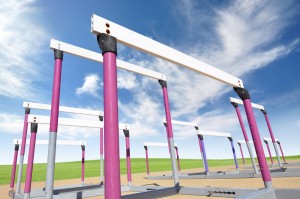
The World Sports Trauma Congress 17th -20th October 2012, London is being held this week with international speakers discussing topics such as “footballer’s ankle” and “sport after joint replacement”. The congress is connected to the Summer Olympics Games and occurs every four years. This year in London delegates, like us Elves, will undoubtedly be celebrating the athletes of the Paralympics and Olympic Games for not only their physical talent, but their courage, perseverance and mental discipline.
But it made me wonder what it must be like to be an injured athlete who is trying to return to sport – what hurdles do they face in addition to their physical injuries and how can these be overcome? I was pleased to find this question had been posed by the authors of the above paper.
Here’s what they did
This review explored some psychosocial stresses and anxieties common to athletes returning to sport, focussing on issues identified in previous research. The authors acknowledged the review was not exhaustive and concentrated on the potentially problematic source of apprehension that is re-injury anxiety.
Here’s what they found
Returning athletes experience concern about:
- competence – re-injury anxieties, concerns about performing to pre-injury standards;
- autonomy – external and self-induced pressure to return to sport, and
- relatedness – feelings of social isolation and lack of identity
The authors suggested intervention strategies such as;
- graduated physical tests to build confidence,
- positive visual imagery during rehabilitation,
- buddy systems,
- relaxation techniques
- education and advice on how to retrain safely.
Athletes should be involved in determining recovery goals and maintain contact with their training team to provide social support and identity.
The authors also outlined a theoretical framework based on self-determination theory (SDT) and discussed its relevance to sports medicine practitioners in making sense of the return-to-sport experiences and concerns of injured athletes. The psychological needs of competence, autonomy and relatedness are significant to athletes during rehabilitation. It is important that sports medicine practitioners ensure re-injury anxiety does not prevent return to sport.
The authors concluded
“Using the SDT framework to explore intervention efforts and applying suggested strategies can provide them with knowledge of how to reduce or avoid significant athlete concerns.”
The Musculoskeletal Elf’s view

This review was not exhaustive but provides insight into the psychosocial problems facing injured athletes and suggests strategies to manage these. The theoretical framework is described in an earlier paper by the first author of this review and self-determination theory (SDT) has been explored across a variety of situations. A recent systematic review by Teixeira including 66 studies examining SDT, exercise and physical activity concluded that overall the literature provides good evidence for the value of SDT in understanding exercise behaviour.
Returning to sport after injury must be difficult for both the athlete and the rehabilitation team.
- Have you struggled with a sports injury or been responsible for rehabilitating an injured athlete?
- Do you recognise these anxieties and concerns?
- How did you overcome them?
- Would this framework have been useful to you?
Send us your views on this blog and become part of the Musculoskeletal Elf community.
Links
- World Sports Trauma Congress 17th -20th October 2012, London
- Podlog L, Dimmock J, Miller J. A review of return to sport concerns following injury rehabilitation: Practitioner strategies for enhancing recovery outcomes. Physical Therapy in Sport 2011 12 36-42
- Podloga L, Eklundb RC. The psychosocial aspects of a return to sport following serious injury: A review of the literature from a self-determination perspective. Psychology of Sport and Exercise 2007 8 535-566
- Teixeira PJ, Carraça EV, MarklandD, Silva MN, Richard M Ryan RM. Exercise, physical activity, and self-determination theory: A systematic review. International Journal of Behavioral Nutrition and Physical Activity 2012 9:78


Hi Tracey,
I’m currently working with professional athletes as part of a placement and have seen the anxieties and concerns in the mid stages of rehab during the physical rehabilitation process. It has been displayed mostly physically such as reluctance to shift weight quickly and limping in the absence of pain. Some of them were anxious to progress through the different stages as they were afraid they would re-injure. This was verbally expressed. It wasn’t until the athlete had had several attempts at the specially designed circuits that their confidence began to increase as they felt safe in the knowledge that they weren’t going to injure themselves anymore.
Throughout the rehab there were various verbal prompts with regard to limping and decreased quality of movement. The athlete was able to correct after several practices and confidence seemed to improve as speed, agility and quality of movement improved. This also transferred when a new circuit was added whereas previously they hadn’t carried their skills across.
I’m not aware of the SDT framework being used in the practice and also wasn’t aware of the factors such as decreased fitness, social pressures and stress due to not being able to participate with other members fully impacted on the athlete. There are often jokes made about weight gains and fitness loss amongst the other athletes. I don’t know how much the particular sporting environment I’m working in allows for open expression of emotion. However I haven’t been at the place for very long so they probably wouldn’t want to voice concerns with me.
I just thought I would post up my experience of it so far as I will be moving onto a different area soon. I was just wondering how it has helped you and if/how it has changed your approaches to treatment.
Thanks
Hi Roisin, thanks for your comments and sharing your experiences. I had not come across the SDT framework either before reading this article but it contains many areas that therapists address intuitively. I have not yet had the opportunity to use the framework but will in the future as I think it would provide a useful checklist to make sure I have considered all possible factors that could be influencing rehabilitation. Regarding emotional expression, I would agree that the relationship between therapist and athlete is crucial and have found that athletes are apprehensive about opening up in front of peers, but will do so in the confidential environment of the treatment room. One of the benefits of recognising these emotional factors is to be able to reassure the athlete that these fears and anxieties are entirely normal. Hope you enjoyed your placement, thanks for posting!
Lesley